Live aquatic plants create a natural environment for your betta and help clean the water.
Flowering aquarium plants have the extra benefit of adding color and visual interest to a fish tank.
With a wide variety of flowering plants, which ones are best for your betta tank?
1. Amazon Sword (Echinodorus amazonicus)
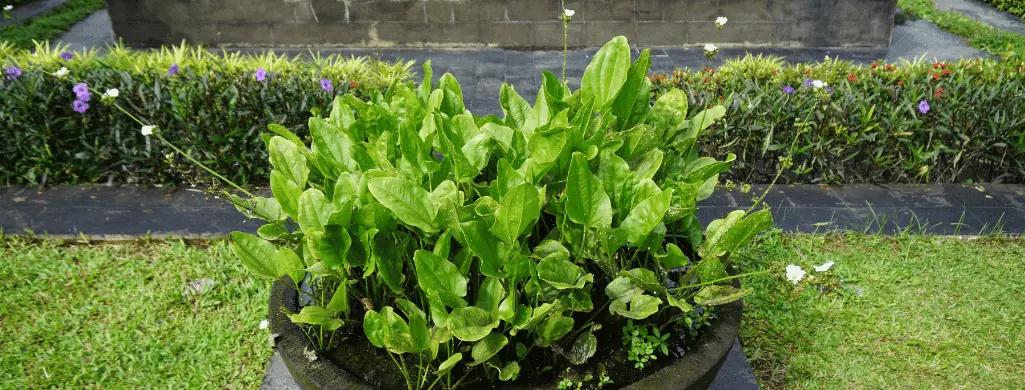
- Growth Rate: Moderate/Fast
- Lighting Needs: Moderate
- Max. Height: 20″ inches
- Plant Care in Aquarium: Easy
Amazon swords are an excellent option for beginners because of their easy-care requirements.
The broad leaves of this plant grow up to 20″ inches tall and provide hiding places for your betta. Amazon swords produce small white flowers on thin stems above the surface in the right conditions.
Your substrate must be at least 2.5″ inches deep to support this plant’s robust root system. Amazon swords can grow in aquarium gravel but thrive in nutrient-rich aquarium soil.
This tall plant has a moderate growth rate and lighting needs. But, it has a rapid growth rate in bright light.
Amazon swords work well as a background plant because of their height.
2. Anubias (Anubias barteri)

- Growth Rate: Slow
- Lighting Needs: Low
- Max. Height: 16″ inches
- Plant Care in Aquarium: Easy
Anubias plants are the most common aquatic plants found in home aquariums.
These slow-growing plants are another great choice for beginners.
You do not need a special substrate for this plant. Anubias grows best when attached to driftwood or rocks.
Anubias barteri has dark green, broad leaves growing from a center rhizome.
With the right care, Anubias produces small flowers. The flowers grow on a long flower stalk from the central rhizome.
Anubias flowers resemble tiny peace lilies with yellow and white colors.
Unlike some flowering aquarium plants, Anubias can bloom underwater and above the surface.
This hardy plant species do not need trimming because of its slow growth. It also thrives in low-light conditions.
3. Water Wisteria (Hygrophila difformis)
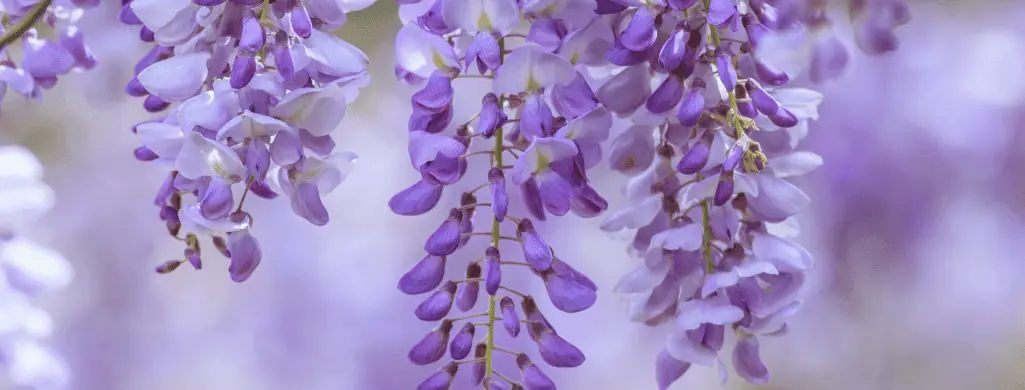
- Growth Rate: Fast
- Lighting Needs: Low/Moderate
- Max. Height: 20″ inches
- Plant Care in Aquarium: Easy
The appearance of water wisteria changes depending on whether it’s submerged in water.
Water wisteria leaves above the water look like strawberry or mint leaves. Underwater, the plant looks more like a fern.
This plant only produces flowers when it grows above the waterline. Water wisteria has purple flowers with white accents and resembles snapdragons.
Due to its rapid growth rate, water wisteria needs routine trimming to keep it from taking over your aquarium.
Water wisteria can grow in the substrate or float on the surface.
4. Cryptocoryne (Cryptocoryne wendtii)

- Growth Rate: Slow
- Lighting Needs: Low/Moderate
- Max. Height: 6-8″ inches
- Plant Care in Aquarium: Easy
Crytpocoryne comes in a wide range of colors, including red, green, bronze, and purple.
This plant has low to moderate light requirements and does not need a lot of maintenance.
Since Cryptocoryne wendtii is a shorter plant, it works well as a mid-ground focal point. In a larger tank, the plant can grow in the foreground.
Cryptocoryne wendtii usually produces flowers above the surface.
The reddish-brown flower has a tubular shape and grows from the center of the plant. Cryptocoryne wendtii is also known as Wendt’s water trumpet.
While this plant is easy to grow, it is sensitive to sudden fluctuations in water parameters.
5. Ludwigia (Ludwigia repens)
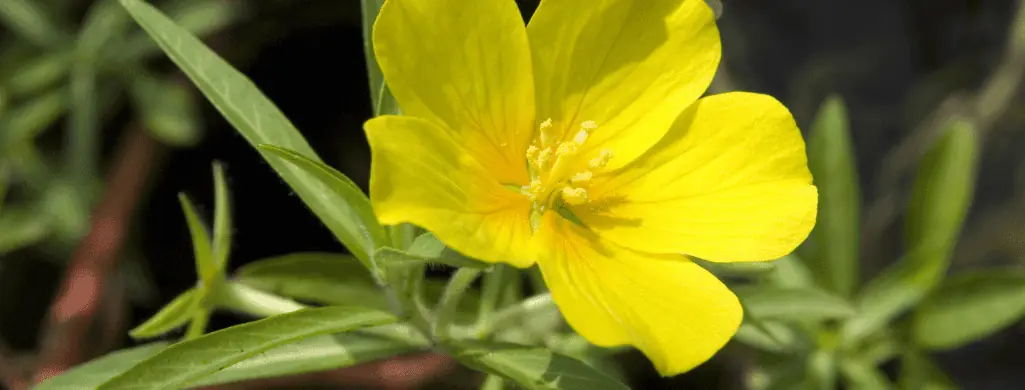
- Growth Rate: Fast
- Lighting Needs: Moderate/High
- Max. Height: 20″ inches
- Plant Care in Aquarium: Easy
Ludwigia repens is a fast-growing plant with colorful red and green leaves growing from reddish-brown stems.
When the plant grows above the surface, it sprouts bright yellow flowers. After the flowers dry up, they drop seeds onto the substrate, producing more plants.
Regular trimming maintains Ludwigia’s bushy appearance.
The colors of Ludwigia are more intense in bright lighting conditions. Just be aware of excess algae growth when using bright aquarium lights.
This plant is an excellent choice for a betta tank because it prefers the same warm water temperatures and parameters.
Ludwigia repens grows best in a nutrient-rich substrate like aquarium soil.
6. Rotala (Rotala rotundifolia)

- Growth Rate: Fast
- Lighting Needs: Moderate
- Max. Height: 12″ inches
- Plant Care in Aquarium: Easy
Rotala rotundifolia is an excellent choice for beginners because it does not need much care.
This is a beautiful plant even when it is not blooming because of its vivid colors.
Rotala rotundifolia red is the most common color. The plant also comes in bright shades of green and pink.
When the stems of this plant grow above water, they develop spiky purple or pink flowers.
Occasional trimming prevents the Rotala from having a busy appearance.
7. Dwarf Sagittaria (Sagittaria subulata)
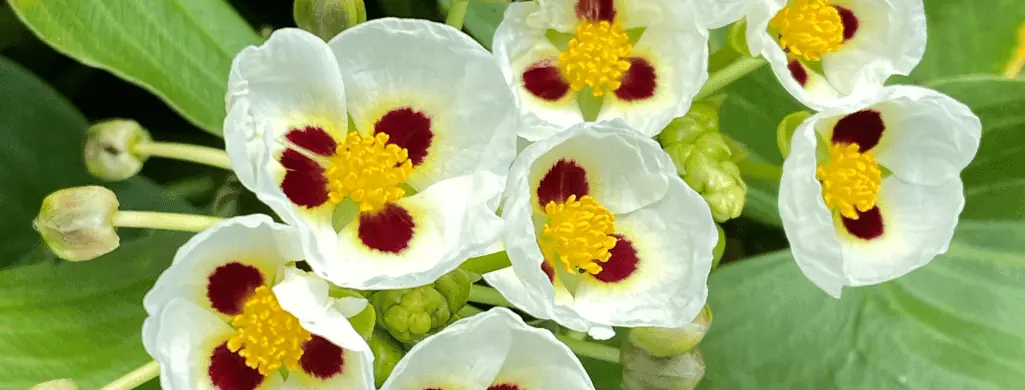
- Growth Rate: Fast
- Lighting Needs: Moderate
- Max. Height: 20″ inches
- Plant Care in Aquarium: Moderate
Dwarf Sagittaria is a fast-growing plant with a grassy appearance.
This plant needs an iron-rich gravel substrate for healthy growth. Without enough iron, the leaves of the plant die and fall off. You can see our list of aquarium plants that thrive in gravel here.
Dwarf Sagittaria grows well in moderate lighting, but the leaves take on a red hue in bright light. You may also add CO2 supplements to the plant for faster growth.
In ideal conditions, Dwarf Sagittaria grows small white flowers with three petals.
8. Dwarf Water Lily (Nymphaea stellata)
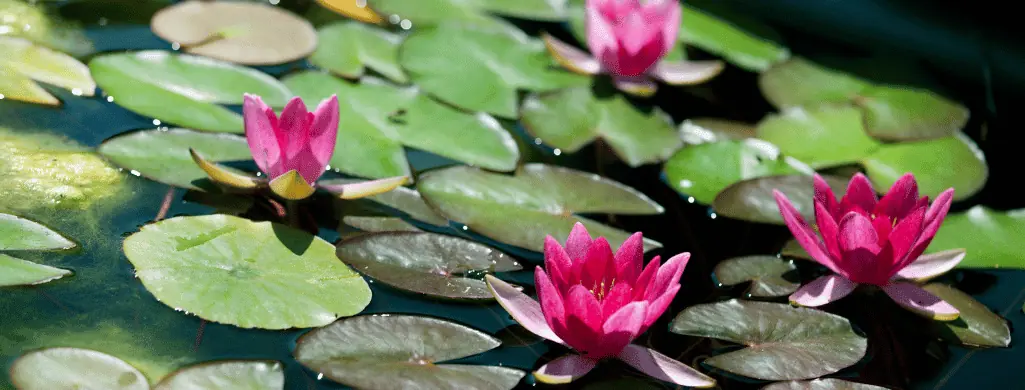
- Growth Rate: Moderate
- Lighting Needs: Moderate
- Max. Height: 6″+ inches
- Plant Care in Aquarium: Moderate
The dwarf water lily is a bulb plant and needs an iron-rich gravel substrate or fertilizer for healthy growth.
In moderate lighting conditions, dwarf water lilies grow underwater leaves. The plant also grows small lily pads on the surface.
On the surface, dwarf water lilies grow beautiful white, yellow, and purple flowers.
Dwarf water lilies do not need regular pruning. But, you must remove the lily pads as they die to prevent extra biological waste in your tank.
These plants are a beautiful option for smaller tanks because they do not grow very large.
9. Red Tiger Lotus (Nymphaea zenkeri)

- Growth Rate: Moderate
- Lighting Needs: Moderate
- Max. Height: 4-6″ inches
- Plant Care in Aquarium: Easy
The red tiger lotus is one of the most beautiful aquatic plants for a betta tank.
Like the dwarf water lily, the red tiger lotus is a bulb plant with lily pad leaves growing up to the surface.
Red tiger lotus plants produce white, purple, or blue flowers with bright yellow centers.
Heart-shaped red leaves grow underwater close to the bulb.
This plant thrives with root tab fertilizers. You may also use fish-safe liquid fertilizers.
10. Hygrophila (Hygrophila polysperma)
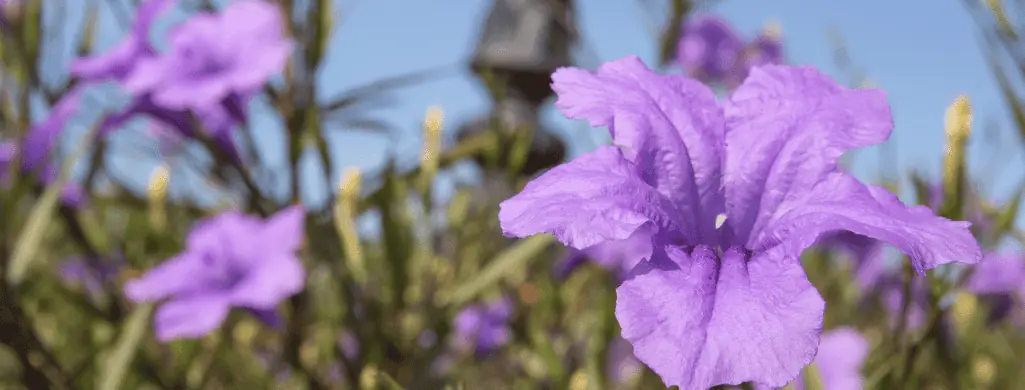
- Growth Rate: Fast
- Lighting Needs: Low/Moderate
- Max. Height: 24″ inches
- Plant Care in Aquarium: Easy
Hygrophila polysperma is native to Southeast Asia and is also found in the Southern parts of North America. It is considered an invasive wild plant and illegal as an aquarium plant in certain parts of the United States.
The leaves of this plant have an orange tint when exposed to light. Small white and pale blue flowers grow on the surface.
Another popular variety of hygrophila is the giant hygrophila (Hygrophila corymbosa). This variety is also known as the temple plant, giant hygro, or starhorn plant.
The giant hygrophila prefers moderate or bright light levels and carbon dioxide supplements for optimum growth.
Giant hygro flowers are pale blue or lavender.
11. Moneywort (Bacopa monnieri)
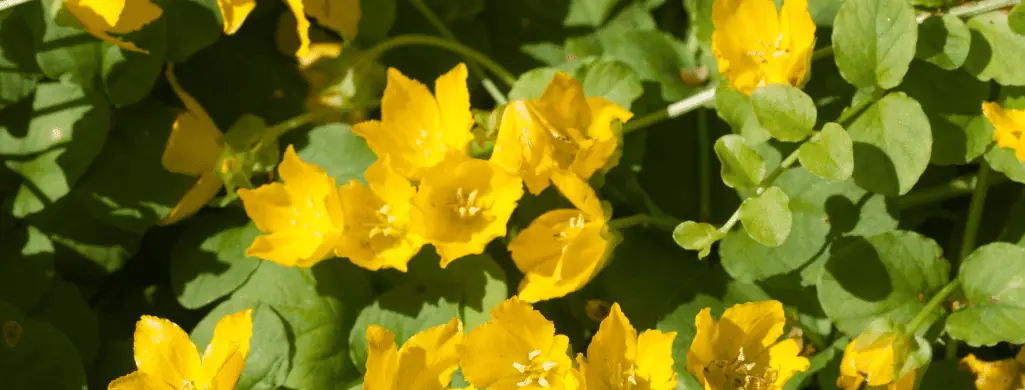
- Growth Rate: Slow
- Lighting Needs: Moderate/Bright
- Max. Height: 11-13″ inches
- Plant Care in Aquarium: Moderate
Moneywort has bright green leaves and stems and produces small white flowers. The flowers sometimes have a light pink or purple hue.
It is usually a middle ground or background plant because of its height.
This plant does not need a carbon dioxide supplement. But, you may use a liquid fertilizer if your plant does not receive enough nutrients.
Moneywort is a hardy plant species, but the leaves are a bit delicate.
The plant has a slow growth rate of about one inch per month.
You may plant moneywort in the substrate or let it float on the surface.
12. Brazilian Pennywort (Hydrocotyle leucocephala)

- Growth Rate: Fast
- Lighting Needs: Moderate/Bright
- Max. Height: 24″ inches
- Plant Care in Aquarium: Easy
Like moneywort, Brazilian pennywort can grow in the substrate or float on the surface.
The round leaves of Brazilian pennywort resemble the leaves of terrestrial plants.
Brazilian pennywort produces small white blooms on thin stems above the water.
Occasional pruning prevents the plant from outgrowing the aquarium.
While Brazilian pennywort has moderate to bright lighting requirements, it can also grow in low light levels.
13. Cardinal Plant (Lobelia cardinalis)
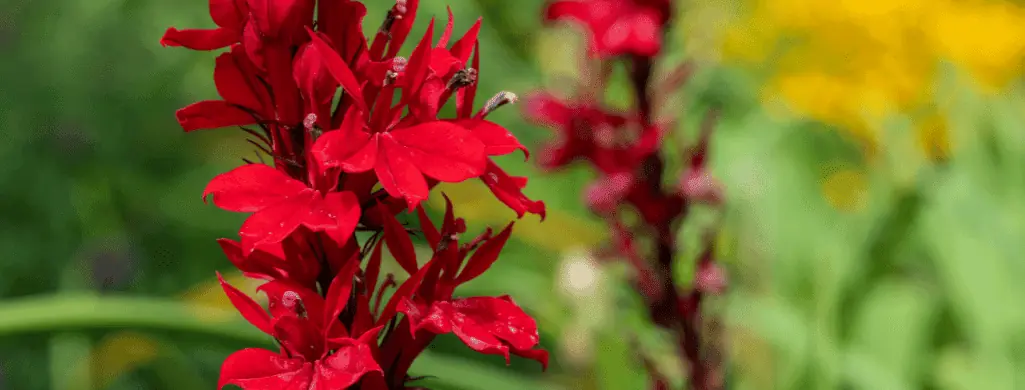
- Growth Rate: Moderate
- Lighting Needs: Moderate/Bright
- Max. Height: 8″ inches
- Plant Care in Aquarium: Easy/Moderate
The cardinal plant is native to North and Central America. It is usually a terrestrial plant but can also grow in an aquarium environment.
When grown submerged, the oval leaves are a bright green color. As the plants grow above the water’s surface, they develop a reddish-purple color on the underside of the leaves.
Cardinal plants also grow bright red flowers above the surface.
Bright light levels give the cardinal plant a bushy appearance. The plant does not thrive in low light levels.
The cardinal plant needs a nutrient-rich substrate or liquid fertilizer for strong growth.
14. Creeping Jenny (Lysimachia nummularia)

- Growth Rate: Fast
- Lighting Needs: Moderate/Bright
- Max. Height: 10″ inches
- Plant Care in Aquarium: Moderate
Creeping Jenny is often mistaken for moneywort. The difference between the two is the color of their flowers.
The flowers of creeping Jenny are a bright yellow color, and the moneywort flowers are white.
This flowering plant grows well in a gravel substrate with moderate lighting.
Creeping Jenny needs regular trimming, or it may outgrow other tank plants.
In some parts of Canada and the United States, creeping Jenny is classified as an invasive weed.
15. Hornwort (Ceratophyllum demersum)

- Growth Rate: Fast
- Lighting Needs: Moderate
- Max. Height: 12″+ inches
- Plant Care in Aquarium: Easy
Hornwort is a unique aquatic plant with thin leaves and a fast growth rate. The leaves grow from the stem in clusters
This plant grows best with a slow water flow. Sudden water disturbances can make the needle-like leaves fall out.
If hornwort does not have ideal living conditions, the needles become stiff. Keep in mind these stiff leaves can tear a betta’s delicate fins.
Hornwort is usually kept as a floating plant. It develops small white flowers above the surface of the water.
16. Vallisneria (Vallisneria Americana)
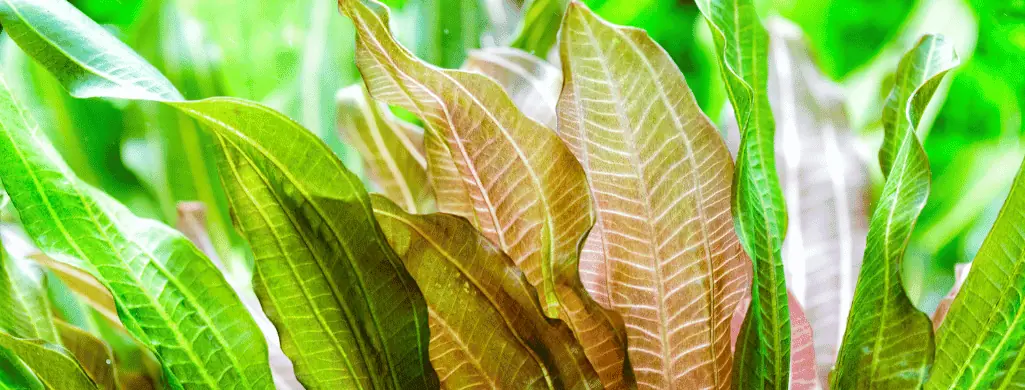
- Growth Rate: Moderate/Fast
- Lighting Needs: Moderate
- Max. Height: 16″ inches
- Plant Care in Aquarium: Easy
Vallisneria Americana is an excellent choice for betta owners of all experience levels.
This plant has tall, ribbon-like leaves and produces long stalks with small white flowers above the surface.
Root tab fertilizers help support the robust root growth of Vallisneria Americana.
If the leaves get damaged, it can take a while for them to recover.
Due to its height and fast growth rate, Vallisneria Americana is not suitable for smaller aquariums.
You may trim the tops of the leaves to keep them from overgrowing the betta tank.
17. Water Lily (Nymphaea lotus)

- Growth Rate: Fast
- Lighting Needs: Moderate/Bright
- Max. Height: 6″+ inches
- Plant Care in Aquarium: Moderate
The water lily, Nymphaea lotus, resembles the red tiger lotus, Nymphaea zenkeri.
Despite their names, the Nymphaea lotus and the red tiger lotus are water lilies and not in the lotus family.
Water lilies are much shorter than lotus plants, and the leaves have different shapes.
Nymphaea lotus is also called the Egyptian water lily.
This water lily usually has a white flower and only opens at night.
Many aquarists keep the leaves trimmed so the water lily does not bloom.
Since the plant has such broad leaves, it grows best in a larger tank.
18. Buce Plant (Bucephalandra)

- Growth Rate: Slow
- Lighting Needs: Low/Moderate
- Max. Height: 10″ inches
- Plant Care in Aquarium: Moderate
The Bucephalandara genus has more than 200 different species.
Each species has a distinct size, color, and shape.
The thick, colorful leaves are usually red, blue, green, or brown.
Bucephalandra plants produce white or pink blooms above the surface of the water.
You may root the plant in your substrate or attach it to a hard surface like driftwood.
While the lighting requirements for Bucephalandara are low, the plant experiences faster growth in moderate to bright light levels. Carbon dioxide supplements can boost plant growth as well.
Bucephalandara grows from a rhizome. Propagate the plant by dividing rhizomes and attaching them to hard surfaces.
19. Banana Plant (Nymphiodes Aquatica)
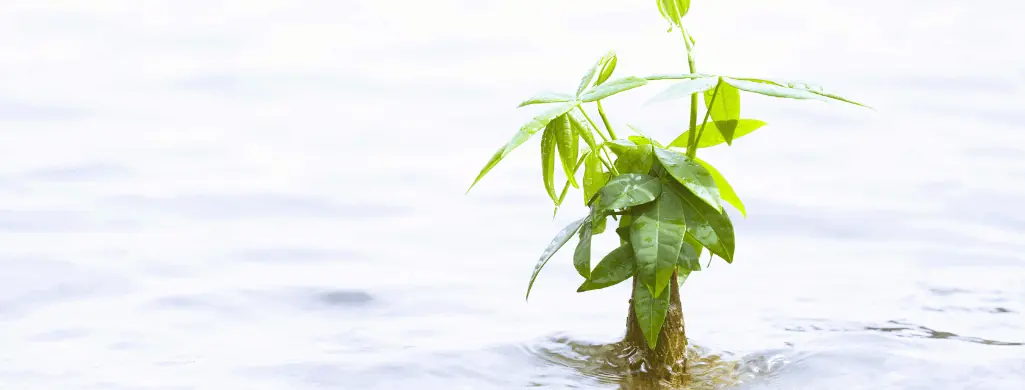
- Growth Rate: Moderate
- Lighting Needs: Low/Moderate
- Max. Height: 18″+ inches
- Plant Care in Aquarium: Easy
The banana plant does not actually produce bananas. This plant gets its name from its tubers, which look like small green bananas.
A banana plant’s tubers store nutrients absorbed from the substrate.
Banana plants produce small lily pads on the surface. In ideal living conditions, small white blooms form.
You may plant the Nymphiodes Aquatica in the substrate or let it float on the surface.
A floating banana plant grows long roots to the substrate.
The tubers must remain slightly above the substrate or the plant will suffocate.
Banana plants need a nutrient-rich substrate or a liquid fertilizer for healthy growth.
You must remove damaged leaves because the plant cannot repair itself.
20. Orchid Lily (Barclaya longifolia)
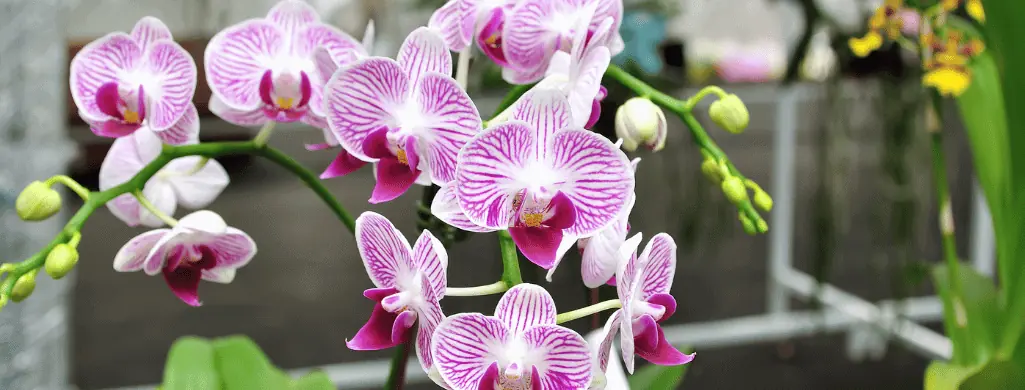
- Growth Rate: Moderate
- Lighting Needs: Moderate
- Max. Height: 30″ inches
- Plant Care in Aquarium: Moderate
The orchid lily is a beautiful plant for a betta tank. It has tender leaves, which are suitable for slow currents.
Orchid lilies need warm water temperatures and moderate lighting for healthy growth.
Cooler temperatures cause slow growth in the plant.
Provide shade for an orchid lily with some floating plants.
The root system of orchid lilies is sensitive. Any damage to the roots can kill the entire plant.
Small aquarium gravel is an ideal choice of substrate for an orchid lily.
Orchid lilies can produce underwater flowers. These small white flowers may not bloom unless they are above the surface.
Even if the flower does not bloom, it still produces seeds for propagation.
21. Ruffled Sword Plant (Aponogeton crispus)
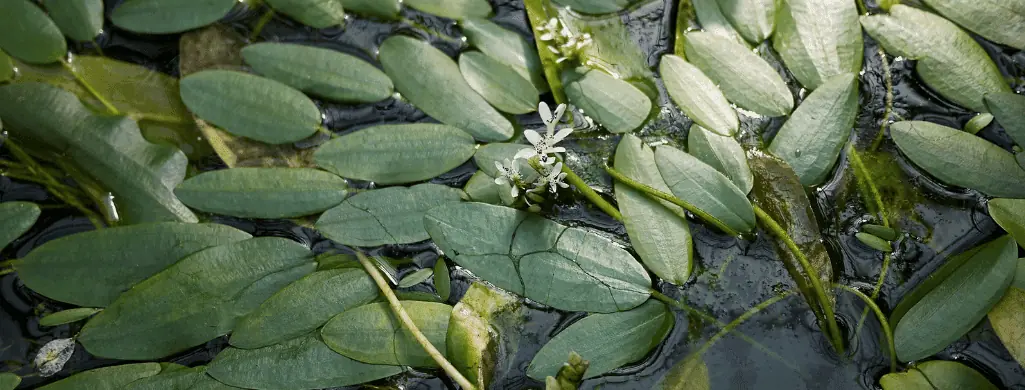
- Growth Rate: Slow
- Lighting Needs: Low/Moderate
- Max. Height: 20″ inches
- Plant Care in Aquarium: Easy/Moderate
The ruffled sword plant has long, wavy leaves with a green or pale brown color.
Ruffled swords are rhizome plants and prefer a nutrient-rich substrate. But, they can do well in aquarium gravel when provided with essential nutrients.
Leave the crown of the rhizome above the substrate for healthy growth.
The ruffled sword blooms often. Small yellow or white flowers bloom at the surface from a long flower stalk.
Ruffled swords are well-suited to the warm temperatures and water parameters of a betta tank.
Your Betta Deserves Flowers, Too!
There are several varieties of flowering plants for your betta tank.
Most of these plants do not produce underwater flowers but bloom on the surface instead.
Many flowering plants have colorful leaves, which are still beautiful even if they do not produce blooms.
When choosing flowering plants for your betta, you must consider your tank size and lighting setup.
Some of these plants have special lighting requirements and need a large tank for healthy growth.
If your aquarium plants are turning yellow, you need to check out this list of reasons and fixes.


